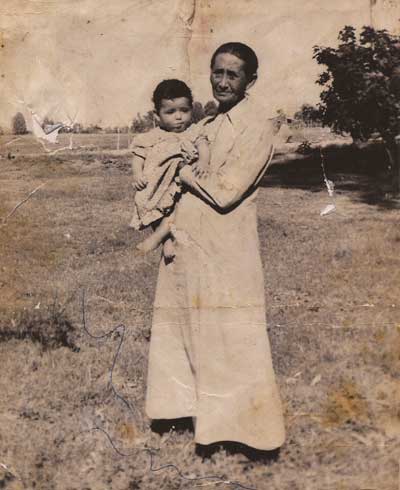
Lucía Martínez was born around 1854 in the Rio Yaqui valley of Sonora, Mexico. The borderlands traffic in Mexican and Indigenous slaves made Indigenous women and children particularly vulnerable, and by 1864, Apache slavers had abducted Lucía into the Black River region of central Arizona. Remarkably, the 10 year-old girl escaped, but she was then found by King S. Woolsey, a renowned Indian killer, who was leading an anti-Apache and gold-scouting expedition in the vicinity. Woolsey held Lucía on his Agua Fria and Aqua Caliente ranches for the next seven years, where she worked with other Indigenous and Mexican laborers caught up in the coercive labor market that characterized Arizona in the Reconstruction Era. By 1871, Lucía aged out of indenture and moved to Yuma, Arizona, where she joined a global community of refugees and upstarts attracted to the Colorado River town that linked Arizona and California, Mexico and the United States in a multilingual and multiracial exchange.
In the seven years Lucía served on Woolsey’s central Arizona ranches, the Yaqui girl bore three illegitimate children to her captor, and when she left his custody in June 1871 to settle in Yuma, Woolsey kept Lucía's two daughters from her.
Arizona's Howell Code included a number of statutes that directly contributed to Lucía Martínez's sexual and economic vulnerability and King Woolsey served in the territorial legislature that put the code into place in 1864. First, the Code allowed non-Indian Arizonans to indenture "minor Indians" without the consent of their parents until they reached the age of 18 (for girls) or 21 (for boys). Second, the Code defined the age of sexual consent as age 10 and banned inter-racial marriage. Third, the Code barred Native witnesses from testifying against non-Indian defendants. Together, these statutes allowed Woolsey to compel Lucía Martínez to work on his ranch from the age of 10-18, made it impossible for her to testify against him if the sex he had with her was non-consensual, and made the children he fathered with her illegitimate.
Despite these deeply intimate legislative interventions in Lucía Martínez's life, the Yaqui woman leveraged a habeas corpus petition in July 1871 against King Woolsey when he tried to keep her two daughters from her. The probate judge who heard Lucía's habeas corpus petition was a close friend of the former territorial senator, but he still awarded custody of the girls to Lucía as he also granted Woolsey an indenture binding both daughters to him until they reached 18. With physical custody, but without legal custody, Lucía Martínez nonetheless managed to keep her family together in Yuma until Woolsey's death in 1879.
Just before Woolsey died unexpectedly of heart problems, he had his daughters removed from their mother and put them into a Catholic convent outside of Yuma. After the father of her children died, Lucía Martínez reclaimed custody of her daughters and pushed lawyers to file an inheritance claim against Woolsey's estate. Although Arizona's miscegenation law made it impossible for Clara and Johana to inherit their father's property, Lucía and her daughters did manage to secure $1000 based on the indenture bond he had signed in 1871. Thereafter, safe from any danger that their father would abuse his authority over them, Lucía Martínez's children adopted his surname, claiming not an inheritance, but a legacy with social currency that territorial Arizonans recognized.
Lucía Martínez's remarkable petition documented Indigenous women’s resistance to coercive legal regimes and her historic measures are featured in a number of scholarly publications. It is her petition that sparked the Petitioning for Freedom project, prompting inquiry into the thousands of habeas petitions other marginalized people filed to challenge interpersonal confinement as Lucía did, in addition to carceral and institutional detention. Drawing on Katrina Jagodinsky’s historical research, Martínez's relatives nominated her to the Arizona Women’s Hall of Fame and she became one of few Native women honored in that venue.
Further reading
- Katrina Jagodinsky, Legal Codes & Talking Trees: Indigenous Women’s Sovereignty in the Sonoran and Puget Sound Borderlands, 1854-1946 (Yale University Press, 2016).
- Katrina Jagodinsky, “Territorial Bonds: Indenture and Affection in Intercultural Arizona, 1864-1894,” in On the Borders of Love and Power: Families and Kinship in the Intercultural American Southwest, ed. David W. Adams & Crista DeLuzio (Berkeley, CA: University of California Press, 2012), pp. 255-277.
- Ned Blackhawk, The Rediscovery of America: Native Peoples and the Unmaking of U.S. History (Yale University Press, 2023), p 330-333.
Citations
“Lucia Martinez vs. Thomas Barrman, K. S. Woolsey, John Ammerman & Mrs Ammerman,” in Petitioning for Freedom: Habeas Corpus in the American West, 1812-1924, edited by Katrina Jagodinsky, et al. University of Nebraska–Lincoln. https://petitioningforfreedom.unl.edu/cases/item/hc.case.az.001.
Clara Martinez and Grandson Robert Marron Romero, nd; Romero Family Collection reproduced with permission of Viola Romero.

